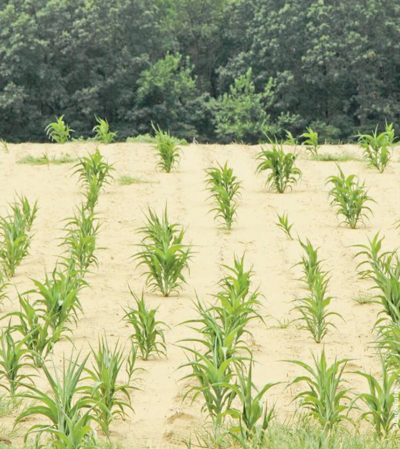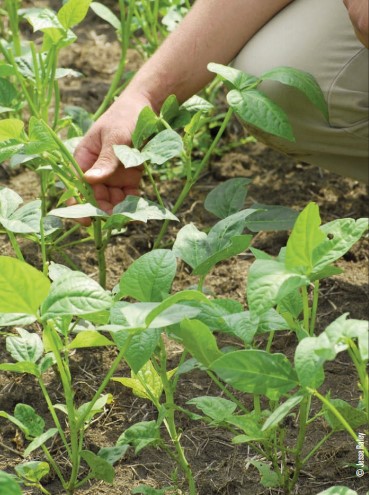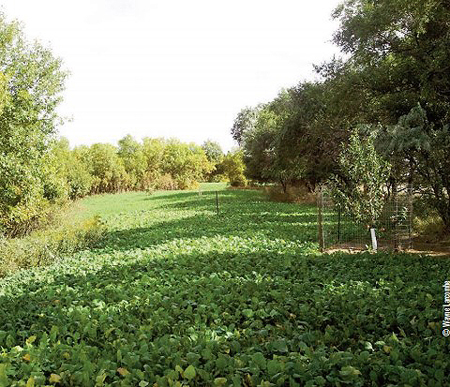Brad Fitzpatrick | Originally published in GameKeepers: Farming for Wildlife Magazine. To subscribe, click here.
Some of the most critical work in science revolves around developing seed blends that are resistant to drought conditions, and that technology is now working its way into food plots.

area. A crop like that pictured is a total failure and worth
nothing to your wildlife.
Ever heard of Norman Borlaug? You probably haven’t, and that’s a shame because Borlaug’s research developing strains of plants that are resistant to drought is credited with saving billions of human lives. Billions! That’s hard to fathom, but it’s true. Just after World War II, Borlaug traveled to Mexico, a country that was forced to import grains to feed its citizens, and his team began crossing different varieties of wheat looking for genetic resistance to disease and drought. The resulting plants were able to grow in dry soils and were resistant to a variety of diseases, namely rust, that plagued Mexican wheat. Borlaug’s efforts dramatically increased the amount of wheat that Mexico could produce, even in arid soils, and his new varieties led Mexico to become a net exporter of wheat. His hybrids were shipped around the world, and soon other countries with arid soils were capable of successfully growing wheat in areas that had traditionally seen low production due to a lack of moisture. His work netted Borlaug a Nobel Peace Prize and he revolutionized agriculture.
Borlaug’s work was critical to helping feed a starving planet, and few other people have had such an important impact on modern agriculture. Today, hybrid plants are commonplace, and they have been used to create a variety of different strains of agricultural crops that produce higher yields, survive in harsher conditions, and are resistant to a variety of diseases. That technology has made its way into every facet of modern farming, and now land managers who plant food plots for wildlife are utilizing hybrids to improve their properties.
Drought continues to be a major concern for farmers and land managers, as evidenced by the recent increase in the price of crops that were affected by a severe drought in the Midwestern United States in 2012. Climatologists and meteorologists believe that the effects of a changing global climate will result in additional periods of drought, making the production of drought-resistant crops critical. For land managers, this ever-increasing technology means there are now strains of plants that have genetic defenses against prolonged periods of drought. For game managers that’s great news.
Deer and Drought
Winter is traditionally considered the most difficult time of the year for big game throughout much of the country. Heavy snowfall and cold temperatures test the metabolic reserves of deer and other animals, and the strain on bucks that enter the cold winter months taxed from the breeding season is well documented. But extended dry periods during the summer months also have a negative impact on deer. Extended periods of low precipitation and the lack of food and cover resulting from it can cause does with nursing fawns to become stressed and in severe cases give up her fawns. They have a constant need to seek out water and food sources.
During these dry periods, food sources can become severely depleted, and this stress leads to a lower recruitment rate among fawns and reduced potential for antler growth for bucks. Because food sources become scarce, deer are forced to work harder to gain nutrition and remain in good health. Diseases like epizootic hemorrhagic disease and the closely related blue tongue become more prevalent as deer crowd together near food and water sources. Despite the stresses that winter can often delve out, a dry summer or fall can have just as big of an impact on the overall health of your deer herd.
Developing a Plan for Drought

you have soybeans or iron & clay peas planted for
your choice of legumes, lablab (pictured here) will fare
better in dry conditions and should also be included.
BioMass all Legume contains all three plant species.
Drought conditions are often unpredictable. Very few game managers consider the “what ifs” associated with prolonged periods with little or no water. In some areas of the country where drought is a common occurrence (and habitually yearly), deer are oftentimes adapted to living in areas with little water. The effects of drought are exacerbated in places that suffer from occasional drought, and deer in these areas are less prepared to deal with extreme periods of dryness. No matter where you live, drought is a potential threat to the game that you manage, and as such, land managers need to be prepared.
Fortunately, the recent boom in the development of plants capable of surviving periods of drought has offered land managers more options to ensure that even if the weather remains dry, the deer and other game will have forage available that will help them maintain health and will reduce the demands on your property. In preparation for planting, successful property managers work to alleviate any potential stresses that could result in an unforeseen decline in overall herd health.
One of the best ways to protect yourself and the deer you manage is to plant seed varieties that are better prepared to survive dry conditions. This requires a basic understanding of plant physiology and a preemptive planting schedule that includes a variety of drough tolerant plants. If your property has plenty of options for deer in dry months, you’ll not only increase your overall herd health, you will create a haven for deer in surrounding areas during these periods. The goal of any planting program is to create a property that meets the needs of the game throughout the year, and there may be no time that this is more critical or valuable than during periods of drought.
Plants are classified into three main metabolic categories; C3, C4, and CAM. C3 plants grow quickly, but they typically do not survive as well in arid conditions as C4 and CAM plants, which require less moisture to be successful. These effects are often visible during dry periods in our own lawns; while many plants will desiccate and dry out during periods of no rain, some, like crabgrass, remain green. This is because crabgrass is a C4 plant, which requires less water, and its metabolic composition allows it to survive better during drought conditions.
Other common CAM and C4 plants are corn, asters, and true desert plants like yucca. Other plants have been genetically altered to be drought tolerant, and finding a plant that has been genetically manipulated to survive in dry conditions requires some research. The good news is that with the current advancements in plant genetic research, you can now purchase plants that are designed to survive better with less water.
One example of a plant blend that is specifically designed for success in areas where moisture is limited is BioLogic’s Texas Draw. Because many areas in Texas frequently experience prolonged periods of dry weather, this blend was designed to produce maximum results with minimal moisture. One of the reasons that Texas Draw is so effective in dry conditions is that it contains chicory, which is a C4 plant that is both palatable to deer and can survive in conditions with little or no water. The other plants in the blend are also chosen for their ability to withstand dry periods.
Planting a blend with high levels of drought tolerant plants like chicory is a good way to protect your food plot against the perils of dry weather, and it will continue to produce excellent forage that will reduce the strain on your deer herd. During dry periods, your deer herd won’t be forced to travel great distances in search of food sources that provide the necessary nutrients for survival.

provide some shade during the day. The hot afternoon sun is
especially dehydrating.
Another good option is plain BioLogic Chicory, which is often blended with other seeds to create an attractive and effective plot mix with the added security of having a dry season plant that will sustain deer in the event of a drought. Chicory is also one of the hardiest plants for food plots, and a single planting can result in upwards of five years or more of sustained growth, so even if dry conditions occur in future years you’ll have a plot that remains attractive to deer while providing them with much-needed nutrients during periods stress. In many areas, chicory is planted in the spring, and it provides effective summer forage for deer. Blending this with a late summer/fall-planted mix like Texas Draw ensures that your deer herd will have the nutrition they need to survive in the worst conditions.
Another plant suited for dry conditions, and again made famous because of how well it performed in the nasty conditions in Texas, is BioLogic’s Lablab. Lablab is a vigorous, prolific legume that is resistant to insects and disease and grows well even in rough or acidic soils. It proves resilient under heavy browsing (once established) and produces an incredible amount of forage. The plants often grow three feet in height or more. Deer are strongly attracted to Lablab’s large, succulent leaves which are an excellent source of protein and phosphorus for antler growth.
Other plants that do better than others in dry weather include alfalfa, certain red clovers, and trefoils for perennials, along with certain brassicas and cereal grains for annuals. Much of how well the plant does under drought conditions is going to depend upon how far along it is in its growth cycle. A newly germinated seedling may not stand a chance, but three or four weeks later after lag phase and once the roots are now able to search deeper it may do fine. It’s always important to establish your crop when you suspect the moisture will be present. Moisture is the most important key for success, yet once established many cultivars will hang in there during even nasty droughts.

help conserve soil moisture. Although turning dry soil is probably better
than working soil that is too wet. Disking wet soil can cause compaction
and results in non-uniform incorporation of any herbicides or fertilizers.
Drought is a deer killer, and many land managers watch their hard work wither away with the drying soil. It’s important not to be caught unaware, and planning ahead ensures that your property will remain viable to deer even during the driest months. The good news is that advances in plant production have allowed hunters to create mixed plots that are sustainable year-round. It’s important to plan for the unexpected when developing a planting schedule and drought is one of the worst situations a land manager can face. And while it’s impossible to protect your plots and your deer against every unexpected calamity, it is possible to help mitigate the effects of drought on your deer herd.
As you begin considering what to plant this year, be sure to add some acreage that serves as a security against dry conditions. Experienced game managers know that it’s too late to make changes when the dry weather arrives, so plan ahead and safeguard your plots against the unexpected. Planting a variety of drought-resistant species like chicory or lablab is one of the best ways to do that, and in the event that dry weather occurs, you’ll know that your acreage will continue to produce even when others fail.






























